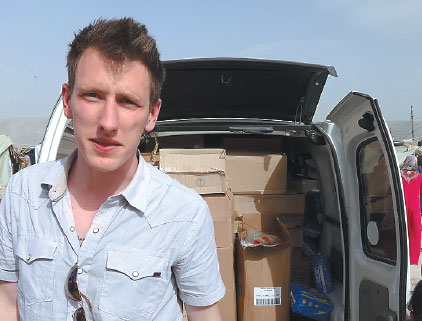IS group claims beheading of US hostage
Video also shows mass execution of at least 18 Syrian military personnel
The Islamic State group on Sunday claimed to have executed Peter Kassig, 26, a US aid worker kidnapped in Syria, as a warning to the United States.
The same video showed the gruesome simultaneous beheadings of at least 18 men described as Syrian military personnel, the latest in a series of mass executions and other atrocities carried out by the IS group.
"This is Peter Edward Kassig, a US citizen of your country," said a militant wearing a similar black outfit worn by the man who beheaded two American journalists and two British aid workers in earlier videos.
The man stood over a severed head bearing a resemblance to Kassig, a former US soldier who risked his life to provide medical treatment and aid to those suffering from Syria's civil war.
"Here, we are burying the first American crusader in Dabiq, eagerly waiting for the remainder of your armies to arrive," the militant said.
Dabiq is the site of a major 16th-century battle in what is now northern Syria that saw the Ottomans defeat the Mamluks and begin a major expansionist phase of an empire the IS group considers to have been the last caliphate.
A White House official said the US intelligence community is working to determine the authenticity of the video.
National Security Council spokeswoman Bernadette Meehan said that if the video is authentic, the White House would be "appalled by the brutal murder of an innocent American". She said the White House expresses its deepest condolences to Kassig's family and friends.
On Saturday, a top US military officer told US troops on a surprise visit to Baghdad that the momentum in the battle with the IS group was "starting to turn", but predicted a drawn-out campaign lasting several years.
General Martin Dempsey, chairman of the Joint Chiefs of Staff, was visiting Iraq for the first time since President Barack Obama responded to IS group advances this summer by ordering troops back into a country they left in 2011.
Hours earlier, an Iraqi army colonel said security forces appeared close to retaking the country's biggest refinery at Baiji, which has been under siege for months by IS group militants.
Obama last week authorized roughly doubling the number of US ground forces as the military expands the reach of its advisers after slowing the militants' advances with US airstrikes.
Dempsey told the troops the US military had helped Iraqi and Kurdish forces "pull Iraq back from the precipice".
"And now, I think it's starting to turn. So well done," Dempsey told a group of Marines at the US embassy in Baghdad.
IS group has captured swaths of territory in both Iraq and Syria, where the US is also conducting airstrikes with its allies in pursuit of Obama's declared objective to "degrade and destroy" the militants.
Dempsey said it had been crucial to show the IS group was not an unstoppable, 10-foot-tall force and instead "a bunch of midgets running around with a really radical ideology".
No troop deployments?
Dempsey repeatedly made the point that military force could not root out the IS group unless Iraq's government manages to work across the Sunni-Shiite divide. Building trust would take time. So would the US mission, he said.
About 1,400 US troops are now in Iraq. Obama's new authorization allows for deployment of up to 3,100.
Responding to Dempsey's remarks that troop deployments in the fight against Islamic extremists were an option, Obama said, "That's his job - to think about various contingencies."
Obama reiterated his desire not to send US combat troops to fight IS group fighters, but said there are always circumstances where the US might need to deploy ground troops.
AP - Reuters - AFP
|
Peter Kassig, a US aid worker whom the Islamic State group claimed on Sunday to have beheaded, stands in front of a truck filled with supplies for Syrian refugees in this file photo. Courtesy Kassig Family / Associated Press |
(China Daily 11/17/2014 page12)















